 |
||||||||||||||||||||||
|
||||||||||||||||||||||
 |
|
| 10.00 - 20.00 | The Accordion
Fair accordions, music books, etc... Venue: Former "Sale" building by Festival Park | Free Admission |
| 11.00 Reviewed Below |
The Finnish
Accordion Folk Musician Championship The five-row Accordion Competition Venue: Commercial Polytechnic, Ikaalinen | Admission: 8 € / 4 € |
| 13.00 - 18.00 Reviewed Below |
Accordion
Groups and Folk Dance Groups performing in the Festival
Park including groups from Kurikka, Kauhajoki and Ikaalinen area. Venue: Festival Park | Admission: Free |
| 13.00 - 24.00 | Accordion
Pub - Meeting place for accordionists and the
public Venue: The Yellow School next to the Festival Park | Admission: Free |
| 17.00 Reviewed Below |
The White
Rose Concert matinée concert featuring
famous Finnish soloists Pentti Hietanen and Johanna Rusanen sing light
classical music with a light music orchestra. Venue: Ikaalinen Hall | Admission: 20 €/ 10 € |
| 20.00 | Zoltán
Orosz Duo in the Country Side the Hungarian duo
of accordionist Zoltán Orosz and guitarist Gabor Ursu and the Orchestra
Keräilyerä. Venue: Iitun pirtti in Isoröyhiö | Admission: 10 €/ 5 € ticket includes coffee |
| 20.00 | The White
Rose Concert featuring famous Finnish soloists
Pentti Hietanen and Johanna Rusanen sing light classical music with a
light music orchestra. Venue: Ikaalinen Hall | Admission: 20 €/ 10 € |
| 20.00 Reviewed Below |
Mika
Väyrynen in Concert a solo concert featuring
the complete Goldberg Variations by J.S. Bach and other premieres. Venue: Ikaalinen Church | Admission: 8 €/ 4 € |
| 20.00 - 24.00 | Dancing
in the Festival Park featuring Mutkattomat, Eki
Jantunen and Jarno Kuusisto. Venue: Festival Park | Admission: 8 €/ 4 € |
| 22.00 Reviewed Below |
The Bryac
Quartet from the Ukraine the Bryac Quartet has
received awards in the International Competition in Poprad, and the quartet
breaks the conventional ideas of a Slavonic balalaika accordion group. Venue: Oma Tupa | Admission: 8 €/ 4 € |
| Five Row Accordion - Finnish Folk Competition | ||||||||
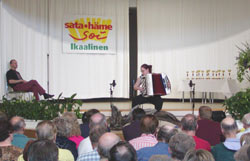 Contestants
took part in this years Five Row Accordion Folk Music Championships
which were held in several different categories, including 12 years
and under, 15 years and under, 18 years and under, and the Veteran category
for players 50 years and older. Contestants
took part in this years Five Row Accordion Folk Music Championships
which were held in several different categories, including 12 years
and under, 15 years and under, 18 years and under, and the Veteran category
for players 50 years and older.A panel of four judges including Risto Ala-Ikkelä, Teppo Välimäki, Riitta Kossi and Jari Komulainen listened as contestants were required to play two (2) Finnish compositions over two rounds. Typical of the Finnish competitions, at the end of each piece the MC took the opportunity to interview the contestant asking informal questions about the choice of music, length of study and hobbies. Not only did this give the judges a chance to work, it also made it quite interesting and often entertaining for the audience. Most of the contestants dressed in traditional costumes for their performances. Pictured below are some of the contestants in the various categories. Results are listed below. |
||||||||
 |
||||||||
 |
||||||||
 |
||||||||
|
Jury
Members: Riitta Kossi, Risto Ala-Ikkelä, Teppo Välimäki,
and Jari Komulainen
|
||||||||
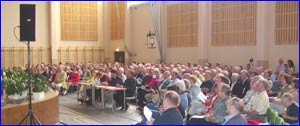 |
||||||||
| Results from the Five Row Finnish Folk Competition | ||||||||
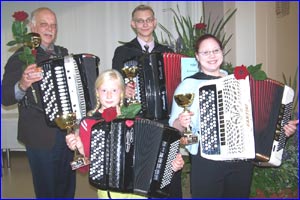 |
||||||||
|
Pictured
left to right are: Kauko Kulmala, Anna
Närhi Sami
Hopponen and Henriikka
Santamaa
Photo courtesy of Minna Plihtari |
||||||||
|
||||||||
| Ikaalinen Festival Park | ||||||||
 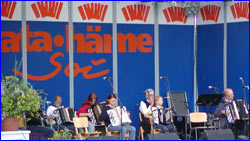 After
the downpour of rain yesterday, festival attendees were thrilled to see
the return of the sun for this afternoons Festival Park performances. After
the downpour of rain yesterday, festival attendees were thrilled to see
the return of the sun for this afternoons Festival Park performances.
The crowds gathered to here to enjoy an array of accordion Folk Music played by groups from Kurikka, Kauhajoki and the Ikaalinen area. Each afternoon features nonstop accordion music at both the Festival Park Stage as well as at the outdoor garden style Accordion Pub allowing attendees to enjoy the outdoor setting and sunshine. |
||||||||
| The White Rose Concert | ||||||||
 The
annual White Rose Concerts featured popular singers Johanna Rusanen (center)
and Pentti Hietanen (right) as they performed with the Vantaa Entertainment
All Stars Orchestra under the direction of Johtaa Markku Johansson (left). The
annual White Rose Concerts featured popular singers Johanna Rusanen (center)
and Pentti Hietanen (right) as they performed with the Vantaa Entertainment
All Stars Orchestra under the direction of Johtaa Markku Johansson (left).Performing solos and duos during the show, the two soloists gave a first rate concert to the capacity audience. |
||||||||
| Mika Väyrynen and the Concert of a Lifetime! | ||||||||
 To
open the concert, accordionist Mika Väyrynen performed the world
premiere of a new work by Kirmo Lintinen called "Puuska". This
new work was commissioned by Mika with funding provided by the Finnish
Accordion Institute which is based in Ikaalinen, so it was only fitting
that the premiere be done here. To
open the concert, accordionist Mika Väyrynen performed the world
premiere of a new work by Kirmo Lintinen called "Puuska". This
new work was commissioned by Mika with funding provided by the Finnish
Accordion Institute which is based in Ikaalinen, so it was only fitting
that the premiere be done here.For Mika Väyrynen, performing the entire Goldberg Variations by Bach is a monumental task. For the audience, it is truly a chance of a lifetime opportunity to hear this magnificent work, not only in its entirety, but also in the hands of such a respected artist. With the genius of J. S. Bach's Goldberg Variations resonating in the walls of the Ikaalinen Church, Mika took the audience on a musical journey from the opening Aria through 30 variations and then some 70 minutes later, magically back to the Aria to deliver what can only be described as a musical masterpiece. 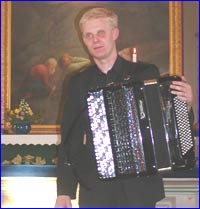 The
fourth time Mika has performed this work in concert, he displayed all
the elements of an artist equal to the best on any instrument. His technical
capability, seemingly effortless and equal in both hands enabled the expert
execution of the variations. With a commanding control of his Jupiter
bayan and seasoned musical prowess, Mika treated the audience of over
250 people to a milestone performance. The
fourth time Mika has performed this work in concert, he displayed all
the elements of an artist equal to the best on any instrument. His technical
capability, seemingly effortless and equal in both hands enabled the expert
execution of the variations. With a commanding control of his Jupiter
bayan and seasoned musical prowess, Mika treated the audience of over
250 people to a milestone performance.The Goldberg variations was composed in 1741. A certain Count Carl von Keyserling, Russian Ambassador to the court of Saxony in Leipzig, suffered from insomnia. There was at the court a harpsichordist by the name of Johann Gottlieb Goldberg, one of whose duties was to help while away his master's sleepless hours by playing him music of a soothing and please nature. This Goldberg was a pupil of Bach's. The Count thus hit upon the idea of requesting Bach to write a few pieces for his resident harpsichordist to play. Bach consented and carried out his request and some 250 years later, the Goldberg Variations live on. 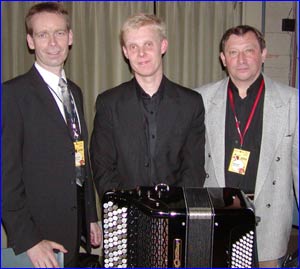 Mika
Väyrynen (pictured center with Festival Musical Director Kimmo Mattila
left, and Professor Oleg Sharov from Russia right) was born October 7th,
1967 in Helsinki, Finland. He studied at the Tampere Conservatory, the
Sibelius Academy (Helsinki) and Gustave Charpentier Conservatory (Paris,
France.) He completed a Master's degree in 1992 and went on to complete
his doctoral degree in 1997. Mika
Väyrynen (pictured center with Festival Musical Director Kimmo Mattila
left, and Professor Oleg Sharov from Russia right) was born October 7th,
1967 in Helsinki, Finland. He studied at the Tampere Conservatory, the
Sibelius Academy (Helsinki) and Gustave Charpentier Conservatory (Paris,
France.) He completed a Master's degree in 1992 and went on to complete
his doctoral degree in 1997.
Among his teachers have been Timo Kinnunen, Matti Rantanen and Max Bonnay. Masterclasses given by Professor Friedrich Lips have also had an important role in Mika artistic development over the years. Mika's
debut recital took place in Tampere, Finland 1985. Since then he has
given hundreds of recitals all over the world including in Austria,
Belgium, Ukraine, China, Croatia, Denmark, Finland, France, Germany,
Iceland, Japan, Netherlands, Norway, Poland, Russia, Slovakia, Sweden
and the USA. He has appeared in venues such as the Salle Pleyel in Paris,
Musashino Hall in Tokyo, Phoenix Hall in Osaka, Kiev Philharmony, The
Gnessin Academy Hall in Moscow, De Ijsbreker in Amsterdam, Sibelius
Academy, Tampere Hall and Sibelius Hall in Finland.
|
||||||||
| The Bryac Quartet from the Ukraine | ||||||||
 |
||||||||
|
|
||||||||
| In and Around Ikaalinen | ||||||||
 Finland's
Nature Symbols: Six national 'nature symbols' have been chosen for
Finland by popular vote and all the symbols carry powerful connotations
of popular tradition, stretching back to ancient times. Finland's
Nature Symbols: Six national 'nature symbols' have been chosen for
Finland by popular vote and all the symbols carry powerful connotations
of popular tradition, stretching back to ancient times. They were only officially chosen in the 1980s and '90s, however, so one cannot claim they are based on any formal tradition. The aim in choosing the symbols is to draw attention to Finnish nature and wildlife and to promote appreciation of them. Symbol Number 3: Granite is made up from quartz, feldspar and mica, with fairly coarse and clearly discernible grains of the different minerals. In Finland, granite is often used for buildings, but also for sculpture. While it is perhaps best suited to more roughhewn works, it also has been used for very delicate pieces of sculpture. 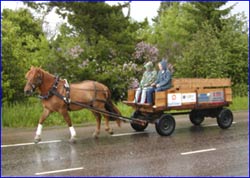 Variation
to Local Transportation: For those wishing an alternative to the
local transportation, you might like to take a ride on this horse and
buggy. Variation
to Local Transportation: For those wishing an alternative to the
local transportation, you might like to take a ride on this horse and
buggy. |
||||||||
|
|

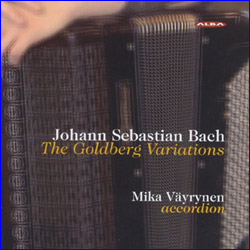 To
date, Mika Väyrynen has recorded thirteen CD's which include over
90 compositions. He has recorded on world famous labels such as Finlandia
Records/Warner Classics, JVC Victor Japan, ALBA and Naxos. Since 1985
he has recorded regularly with the Finnish Broadcasting Company (YLE).
To
date, Mika Väyrynen has recorded thirteen CD's which include over
90 compositions. He has recorded on world famous labels such as Finlandia
Records/Warner Classics, JVC Victor Japan, ALBA and Naxos. Since 1985
he has recorded regularly with the Finnish Broadcasting Company (YLE).  After
a preview of their energetic and contemporary style while performing
a piece on the televised Golden Accordion Award the night before, the
standing room only audience at the Oma Tupa was eagerly awaiting the
Bryac Quartet's return, this time for an entire concert, and they were
not disappointed!
After
a preview of their energetic and contemporary style while performing
a piece on the televised Golden Accordion Award the night before, the
standing room only audience at the Oma Tupa was eagerly awaiting the
Bryac Quartet's return, this time for an entire concert, and they were
not disappointed!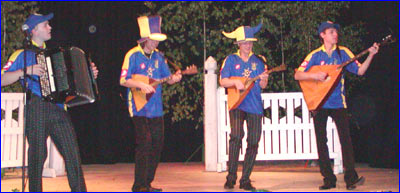 The
four musicians including accordionist Sergei Trotsenko, and Balalaika
players Igor Nerovnui, Jevgeni Kazantsantsev and Oleg Shaman displayed
excellent ensemble work, an innovative and fresh style plus superb dynamic
control. Their dazzling program destroys all Balalaika stereotypes as
they perform rock, jazz, pop and folk in their own unique style which
even includes choreography dance steps and a costume change.
The
four musicians including accordionist Sergei Trotsenko, and Balalaika
players Igor Nerovnui, Jevgeni Kazantsantsev and Oleg Shaman displayed
excellent ensemble work, an innovative and fresh style plus superb dynamic
control. Their dazzling program destroys all Balalaika stereotypes as
they perform rock, jazz, pop and folk in their own unique style which
even includes choreography dance steps and a costume change.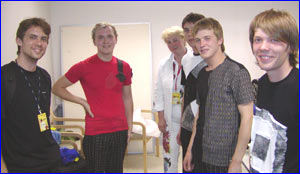 Making
their first appearance in Finland, the audience brought back the Bryac
for several encores after a show full of excitement, fun and surprises.
Making
their first appearance in Finland, the audience brought back the Bryac
for several encores after a show full of excitement, fun and surprises.